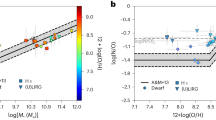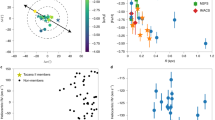Abstract
The first stars are predicted to have formed within 200 million years after the Big Bang1, initiating the cosmic dawn. A true first star has not yet been discovered, although stars2,3,4 with tiny amounts of elements heavier than helium (‘metals’) have been found in the outer regions (‘halo’) of the Milky Way. The first stars and their immediate successors should, however, preferentially be found today in the central regions (‘bulges’) of galaxies, because they formed in the largest over-densities that grew gravitationally with time5,6. The Milky Way bulge underwent a rapid chemical enrichment during the first 1–2 billion years7, leading to a dearth of early, metal-poor stars8,9. Here we report observations of extremely metal-poor stars in the Milky Way bulge, including one star with an iron abundance about 10,000 times lower than the solar value without noticeable carbon enhancement. We confirm that most of the metal-poor bulge stars are on tight orbits around the Galactic Centre, rather than being halo stars passing through the bulge, as expected for stars formed at redshifts greater than 15. Their chemical compositions are in general similar to typical halo stars of the same metallicity although intriguing differences exist, including lower abundances of carbon.
This is a preview of subscription content, access via your institution
Access options
Subscribe to this journal
Receive 51 print issues and online access
$199.00 per year
only $3.90 per issue
Buy this article
- Purchase on Springer Link
- Instant access to full article PDF
Prices may be subject to local taxes which are calculated during checkout



Similar content being viewed by others
References
Bromm, V., Yoshida, N., Hernquist, L. & McKee, C. F. The formation of the first stars and galaxies. Nature 459, 49–54 (2009)
Christlieb, N. et al. A stellar relic from the early Milky Way. Nature 419, 904–906 (2002)
Caffau, E. et al. An extremely primitive star in the Galactic halo. Nature 477, 67–69 (2011)
Keller, S. C. et al. A single low-energy iron-poor supernova as the source of metals in the star SMSS J031300.36–670839.3. Nature 506, 463–466 (2014)
Tumlinson, J. Chemical evolution in hierarchical models of cosmic structure. II. The formation of the Milky Way stellar halo and the distribution of the oldest stars. Astrophys. J. 708, 1398–1418 (2010)
Salvadori, S., Ferrara, A., Schneider, R., Scannapieco, E. & Kawata, D. Mining the Galactic halo for very metal-poor stars. Mon. Not. R. Astron. Soc. 401, L5–L9 (2010)
Feltzing, S. & Gilmore, G. Age and metallicity gradients in the Galactic bulge. Astrophys. Space Sci. 265, 337–340 (1999)
García Pérez, A. E. et al. Very metal-poor stars in the outer Galactic bulge found by the APOGEE survey. Astrophys. J. 767, L9 (2013)
Howes, L. M. et al. The Gaia-ESO survey: the most metal-poor stars in the Galactic bulge. Mon. Not. R. Astron. Soc. 445, 4241–4246 (2014)
Keller, S. C. et al. The SkyMapper Telescope and the Southern Sky Survey. Publ. Astron. Soc. Aust. 24, 1–12 (2007)
Bernstein, R., Shectman, S. A., Gunnels, S. M., Mochnacki, S. & Athey, A. E. MIKE: a double echelle spectrograph for the Magellan Telescopes at Las Campanas Observatory. Proc. SPIE 4841, 1694–1704 (2003)
Gustafsson, B. et al. A grid of MARCS model atmospheres for late-type stars. Astron. Astrophys. 486, 951–970 (2008)
Lind, K., Bergemann, M. & Asplund, M. Non-LTE line formation of Fe in late-type stars — II. 1D spectroscopic stellar parameters. Mon. Not. R. Astron. Soc. 427, 50–60 (2012)
Udalski, A., Szymański, M. K. & Szymański, G. OGLE-IV: fourth phase of the Optical Gravitational Lensing Experiment. Acta Astron. 65, 1–38 (2015)
Robin, A. C., Marshall, D. J., Schultheis, M. & Reylé, C. Stellar populations in the Milky Way bulge region: towards solving the Galactic bulge and bar shapes using 2MASS data. Astron. Astrophys. 538, A106–A120 (2012)
Greif, T. H. et al. Formation and evolution of primordial protostellar systems. Mon. Not. R. Astron. Soc. 424, 399–415 (2012)
Placco, V. M., Frebel, A., Beers, T. C. & Stancliffe, R. J. Carbon-enhanced metal-poor star frequencies in the Galaxy: corrections for the effect of evolutionary status on carbon abundances. Astrophys. J. 797, 21 (2014)
Tumlinson, J. Carbon-enhanced metal-poor stars, the cosmic microwave background, and the stellar initial mass function in the early universe. Astrophys. J. 664, L63–L66 (2007)
Schlaufman, K. C. & Casey, A. R. The best and brightest metal-poor stars. Astrophys. J. 797, 13 (2014)
Frebel, A., Johnson, J. L. & Bromm, V. Probing the formation of the first low-mass stars with stellar archaeology. Mon. Not. R. Astron. Soc. 380, L40–L44 (2007)
Kobayashi, C., Ishigaki, M. N., Tominaga, N. & Nomoto, K. The origin of low [α/Fe] ratios in extremely metal-poor stars. Astrophys. J. 785, L5 (2014)
Umeda, H. & Nomoto, K. Nucleosynthesis of zinc and iron peak elements in population III type II supernovae: comparison with abundances of very metal poor halo stars. Astrophys. J. 565, 385–404 (2002)
Nomoto, K. et al. Nucleosynthesis in black-hole-forming supernovae and extremely metal-poor stars. Prog. Theor. Phys. 151 (Suppl.), 44–53 (2003)
Yong, D. et al. The most metal-poor stars. II. Chemical abundances of 190 metal-poor stars including 10 new stars with [Fe/H] ≤ –3.5. Astrophys. J. 762, 26–63 (2013)
Karlsson, T., Bromm, V. & Bland-Hawthorn, J. Pregalactic metal enrichment: the chemical signatures of the first stars. Rev. Mod. Phys. 85, 809–848 (2013)
Sneden, C., Bean, J., Ivans, I., Lucatello, S. & Sobeck, J. MOOG: LTE line analysis and spectrum synthesis. Astrophysics Source Code Library http://adsabs.harvard.edu/abs/2012ascl.soft02009S (2012)
Barklem, P. S., Piskunov, N. & O’Mara, B. J. Self-broadening in Balmer line wing formation in stellar atmospheres. Astron. Astrophys. 363, 1091–1105 (2000)
Ness, M. et al. Young stars in an old bulge: a natural outcome of internal evolution in the Milky Way. Astrophys. J. 787, L19 (2014)
Ryde, N. et al. Chemical abundances of 11 bulge stars from high-resolution, near-IR spectra. Astron. Astrophys. 509, A20–A35 (2010)
Sharp, R. et al. Performance of AAOmega: the AAT multi-purpose fiberfed spectrograph. Proc. SPIE 6269, 1–13 (2006)
de Laverny, P., Recio-Blanco, A., Worley, C. C. & Plez, B. The AMBRE project: a new synthetic grid of high-resolution FGKM stellar spectra. Astron. Astrophys. 544, A126–A137 (2012)
Kelson, D. MIKE pipeline http://code.obs.carnegiescience.edu/mike (2014)
Casey, A. R. A tale of tidal tails in the Milky Way. Preprint at http://arXiv.org/abs/1405.5968 (2014)
Barklem, P. S. Non-LTE Balmer line formation in late-type spectra: effects of atomic processes involving hydrogen atoms. Astron. Astrophys. 466, 327–337 (2007)
Norris, J. E. et al. The most metal-poor stars. I. Discovery, data, and atmospheric parameters. Astrophys. J. 762, 25 (2013)
Asplund, M., Grevesse, N., Sauval, A. J. & Scott, P. The chemical composition of the Sun. Annu. Rev. Astron. Astrophys. 47, 481–522 (2009)
Lind, K., Asplund, M. & Barklem, P. S. Departures from LTE for neutral Li in late-type stars. Astron. Astrophys. 503, 541–544 (2009)
Lind, K., Asplund, M., Barklem, P. S. & Belyaev, A. K. Non-LTE calculations for neutral Na in late-type stars using improved atomic data. Astron. Astrophys. 528, A103–A112 (2011)
Jacobson, H. R. et al. High-resolution spectroscopic study of extremely metal-poor star candidates from the SkyMapper survey. Astrophys. J. 807, 171 (2015)
Lucatello, S. et al. The frequency of carbon-enhanced metal-poor stars in the Galaxy from the HERES sample. Astrophys. J. 652, L37–L40 (2006)
Schlegel, D. J., Finkbeiner, D. P. & Davis, M. Maps of dust infrared emission for use in estimation of reddening and cosmic microwave background radiation foregrounds. Astrophys. J. 500, 525–553 (1998)
Casagrande, L., Portinari, L. & Flynn, C. Accurate fundamental parameters for lower main-sequence stars. Mon. Not. R. Astron. Soc. 373, 13–44 (2006)
Poleski, R. et al. An asymmetric streaming motion in the Galactic bulge X-shaped structure revealed by OGLE-III proper motions. Astrophys. J. 776, 76 (2013)
Robin, A. C., Reylé, C., Derrière, S. & Picaud, S. A synthetic view on structure and evolution of the Milky Way. Astron. Astrophys. 409, 523–540 (2003)
Bovey, J. galpyhttp://github.com/jobovy/galpy (2015)
Bovy, J. galpy: A python library for galactic dynamics. Astrophys. J. 216, 29 (2015)
Acknowledgements
This paper includes data gathered with the 6.5-m Magellan Telescopes located at Las Campanas Observatory, Chile. Australian access to the Magellan Telescopes was supported through the Collaborative Research Infrastructure Strategy of the Australian Federal Government. L.M.H. and M.A. were supported by the Australian Research Council (FL110100012). A.R.C. acknowledges support from the European Union FP7 programme through ERC grant number 320360. Research on metal-poor stars with SkyMapper is supported through Australian Research Council Discovery Projects grants DP120101237 and DP150103294 (principal investigator G.S.D.C.). The OGLE project received funding from the NSC, Poland (MAESTRO grant 2014/14/A/ST9/00121 to A.U.).
Author information
Authors and Affiliations
Contributions
The project was initiated and led by M.A. The photometric target selection was made by L.M.H., C.I.O. and D.M.N. using data from the SkyMapper telescope developed by B.P.S., S.C.K., G.S.D.C., M.S.B. and P.T. The low-resolution spectra were obtained by L.M.H and C.I.O. The data were reduced and analysed by L.M.H. using software developed by A.R.C. Target selection for the high-resolution observations was done by L.M.H., M.A. and A.R.C. with the observations carried out by L.M.H. and D.Y.; the reduction and subsequent chemical analysis was completed by L.M.H. K.L. performed the non-LTE spectral line formation calculations, C.K. interpreted the observed chemical abundances in terms of supernova yields, and M.N. provided comparison bulge data. R.P., A.U., M.K.S, I.S., G.P., K.U., Ł.W., P.P., J.S., S.K. and P.M. obtained the OGLE observations, A.U. and M.K.S. constructed the reference images, and R.P. measured the proper motions. The manuscript was written by M.A., L.M.H. and A.R.C. with all authors contributing comments.
Corresponding author
Ethics declarations
Competing interests
The authors declare no competing financial interests.
Extended data figures and tables
Extended Data Figure 1 The C–H band of SMSS J181609.62−333218.7.
The C–H band is used to derive an upper limit for C in our most metal-poor star, SMSS J181609.62−333218.7. Synthetic spectra with abundances of [C/Fe] = 0.06 (blue) and [C/Fe] = 0.56 (red) are shown for comparison.
Rights and permissions
About this article
Cite this article
Howes, L., Casey, A., Asplund, M. et al. Extremely metal-poor stars from the cosmic dawn in the bulge of the Milky Way. Nature 527, 484–487 (2015). https://doi.org/10.1038/nature15747
Received:
Accepted:
Published:
Issue Date:
DOI: https://doi.org/10.1038/nature15747
This article is cited by
-
Impact of Distance Determinations on Galactic Structure. II. Old Tracers
Space Science Reviews (2018)
Comments
By submitting a comment you agree to abide by our Terms and Community Guidelines. If you find something abusive or that does not comply with our terms or guidelines please flag it as inappropriate.



